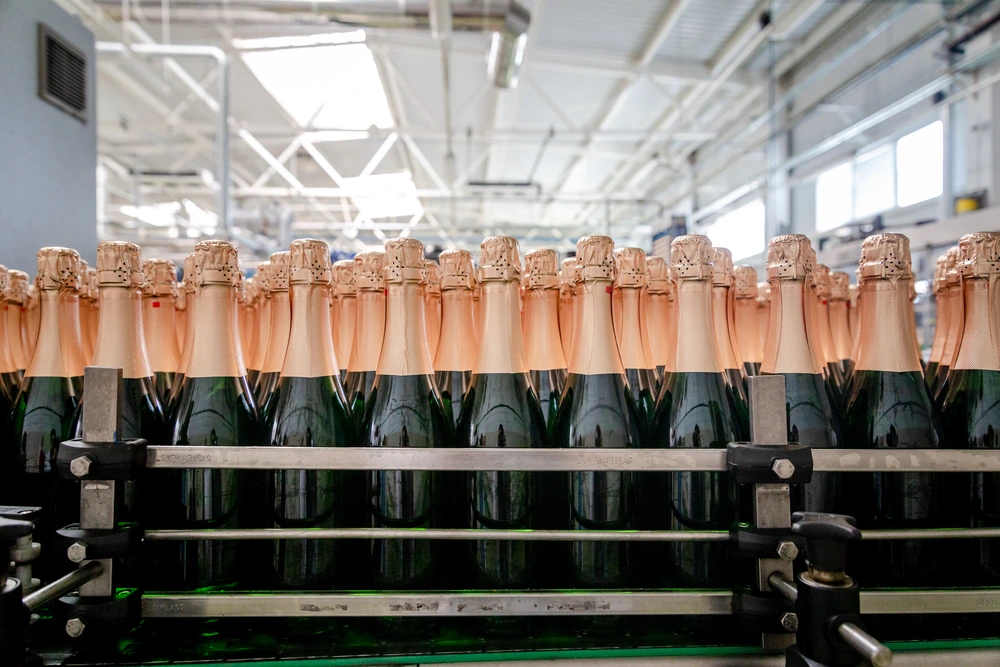You’ve probably heard of the phrase “drinking to someone’s health”? Its deep origin dates back to Ancient Greece. During dinner, the host was expected to sip the wine as assurance that the drink was not poisoned.
It’s either that the society was extra careful, or their hosts had an otherwise reputation with wine…
Either way, the willingness to attend a dinner with ‘suspicious wine’ and a guilty host-until proven innocent-is evidence enough that wine was, and still is the beloved drink of the centuries and sparkling wine is the fancy form of it.
However, a lot of people get confused about the differences between Champagne and sparkling wine. Do you know the differences between these two? Read on for insights.

Champagne Can Only Be Made In France
To many people, any wine with bubbles is Champagne, but this is not the case.
You can only say sparkling wine is Champagne if you check the label. Where was it made? If it’s anything other than Champagne, France, then just call it sparkling wine.
The Champagne wine region is a place in the North East of France and is famous for the unique wine produced there since the Middle Ages.

Champagne, as we know it today, was first made in between the 17th and 18th centuries by a French monk, Dom Perignon.
Perignon’s secret was adding just the right amount of sugar in still wine to make it sparkle. Today, the process is much more complex.
During the secondary fermentation process, a mixture known as liqueur de tirage (mixture of yeast nutrients and sugar) is added to the wine, and the product is allowed to ferment to become sparkling wine.
The carbon dioxide gas produced in the process of fermentation is the reason for the fizzy and bubbly nature of Champagne.
France has tight restrictions safeguarding its champagne brand, requiring that all sparkling wines be labeled as so unless they are produced in the region of Champagne.
Interestingly, Russia has its version of Champagne known as “shampanskoye.”
Russia also passed legislation requiring all foreign sparkling wines to be labeled as so. Does this mean no Champagne in Russia? Well, shampanskoye can save the day.
Only These Grapes Are Allowed
The three main grapes used in producing Champagne are Pinot Noir, Chardonnay, and Pinot Meunier. Let’s call them the “Champagne’s holy trinity.”
Pinot Gris, Pinot Blanc, Petit Meslier, and Arbane can also be used in limited amounts.
- Pinot Noir: This black grape gives structural texture and distinctive aromas of red berries to the Champagne. It is the most widely planted grape, accounting for 38% of plantings.
- Chardonnay: This white grape adds a delicate fragrance of flower and citrus. They account for 30% of grape plantings.
- Pinot Meunier: This black grape gives the Champagne a red fruit flavor with a round sensation. It accounts for 32% of grape plantings. Pinot Meunier can now make 100% Meunier Champagne which is growing in popularity.
Fermentation Is Different For Champagne Than Sparkling Wine

This is true and also false. The fermentation process of Champagne and sparkling wine is the same; both undergo primary and secondary fermentation processes.
However, the process of making champagne is much more complex and regulated.
France has a law known as Appellation d’Origine Controlée (AOC), which defines the processes of champagne making – from planting the grapes to the final process of winemaking.
The primary fermentation transforms natural grape sugars into alcohol and carbon dioxide. Winemakers use steel tanks or wood for primary fermentation.
The secondary fermentation (malolactic fermentation) is the process that produces that bubbly taste that everyone loves.
There are two ways to achieve the sparkle:
- Traditional method: The second fermentation process takes place in the bottle after adding sugar and yeast. Champagne makers use this method when making Champagne. The traditional way gives Champagne smaller bubbles.
- Tank (Charmat) method: Unlike the traditional approach that uses a bottle for the second fermentation, this method uses a large steel tank. After adding yeast and sugar, the wine is left in the steel tank for some time. The tank method makes the wine have large bubbles.
The carbonation level will depend on the fermentation method used in the second fermentation. The malolactic fermentation gives the wine a creamy mid-palate texture.
The higher the carbonation level, the finer the Champagne becomes.
What Is Sparkling Wine?
Sparkling wine is any wine that has significant levels of carbon dioxide in it.
You refer to wine as sparkling if it goes through secondary fermentation to form a bubbly feeling when you drink.
This is achieved by adding sugar and yeast to still wine and allowing fermentation to take place.
Types of Sparkling Wine
Winemakers are producing different sparkling wines as the popularity of their bubbly quality continues to grow across the globe.
Here are the most common types of sparkling wines:
- Champagne: This is the most popular type of sparkling wine. People often refer to sparkling wine as Champagne (but you know better now). It originates from France, has a fruity taste, and fits all occasions.
- Prosecco: It originates from the Prosecco village in Italy. It has a sweeter taste and forms larger bubbles. You can use it as an addition to cocktails. It’s made from Glera grapes using the Charmat method. As a bonus, Prosecco is low in calorie count.
- Cava: This sparkling wine originates from Spain. It’s made from Spanish grapes such as Macabeo, Parellada, and Xarel·lo.
- Crémant d’Alsace: Comes from the Alsace region in France. It’s made from the same traditional method as Champagne, but the flavor differs. It has soft bubbles with a creamy taste.
- Sekt: This type of sparkling wine is mainly made through the Charmat method, but can also be made using the traditional method. It originates from Germany, and it’s primarily for local consumption. Sekt is cheaper and sweeter with less alcohol than Champagne.
- Petillant Naturel: French for “naturally sparkling”. This sparkling wine is made using a more hands-off method called Methode Ancestrale. Unlike other sparkling wines, these don’t go through a secondary fermentation period.
How Do You Know When Sparkling Wine is Dry?
Check the label on the bottle to know the level of dryness in your sparkling wine. It’s available as:
- Brut Zero: This is the driest of them all, residual sugar is less than three grams per liter.
- Extra brut or Extra dry: A sparkling wine with 0-6 grams of residual sugar per liter. It’s sweeter than brut.
- Brut: It has a sugar level between 0-12 grams per liter.
- Sec: Residual sugar is between 12-17 grams per liter.
- Demi-sec: Has 33-50 grams of sugar and is great for dessert.
- Doux: This is the sweetest wine and contains more than 50 grams of sugar.
FAQs About Champagne and Sparkling Wine
Sparkling wine enthusiasts and beginners often ask the following questions:
Are Champagne Grapes Used to Make Champagne?
No. Contrary to their name, Champagne grapes, also referred to as black Corinth or Zante currant, are not used to make Champagne.
Instead, they are seedless grapes used for decorative purposes in dessert fruits, salads, and a snack in cheese. They are also dried and retail as raisins.
Does Champagne Cost the Same as Sparkling Wine?
No. Champagne is more expensive (Although Aldi has a great wallet-friendly option). Sparkling wine is affordable.
The luxurious region where Champagne is produced contributes to the price difference. Also, quality, method of production, and consumer loyalty and affinity cause champagne to be expensive.
- Shrimp Cocktail (and More) Wine Pairing Guide - 09/06/2022
- What Wine Serving Sizes Look Like: Standard Size and More - 08/06/2022
- How Much Sugar is in Wine: Glass and Bottle Sugar Content - 08/06/2022






